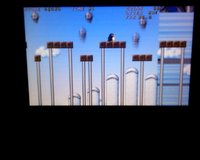Mr Rob
Active Member
Hello all:
First off, I am a Linux guy, but it tends to be more geared toward servers, and less games/graphics, so that's my general background.
I currently have a functioning copy of "Super Tux 2" (0_3_3 downloaded from their SVN) running on my Pandora. I built on the Pandora itself, and when cmake barked about missing libraries, I just opkg installed them recklessly, uninstalling things if it had a conflict with an already installed file.
I can get it full screen, and changed the resolution in the source to support the Pandora. Bad news is that for the moment, I can only get the SDL renderer to work correctly, and not yet OpenGL (I haven't done the OpenGL ES conversion, I'd need to read a lot about OpenGL yet and was hoping to make it work without learning graphics, ha.).
SDL is slow. Slow as in 16 frames per second, and jerky, jumping between 8 and 30.
Questions:
1 Would it be foolish for me to even try to get SDL working faster? Does it have the capabilities or am I better off going down the OpenGL ES route?
2. I remember reading that there were custom made versions of some graphics libraries on everyone's Pandora, is it possible that I overwrote those by using the package manager? Would that result in my current SDL renerer version of Super Tux to be slow?
3. Is anyone else currently working on SuperTux2?
And general tips would be helpful, I don't think I have any other questions at the time.
I really just want to play SuperTux2 on my Pandora, cause it's awesome.
First off, I am a Linux guy, but it tends to be more geared toward servers, and less games/graphics, so that's my general background.
I currently have a functioning copy of "Super Tux 2" (0_3_3 downloaded from their SVN) running on my Pandora. I built on the Pandora itself, and when cmake barked about missing libraries, I just opkg installed them recklessly, uninstalling things if it had a conflict with an already installed file.
I can get it full screen, and changed the resolution in the source to support the Pandora. Bad news is that for the moment, I can only get the SDL renderer to work correctly, and not yet OpenGL (I haven't done the OpenGL ES conversion, I'd need to read a lot about OpenGL yet and was hoping to make it work without learning graphics, ha.).
SDL is slow. Slow as in 16 frames per second, and jerky, jumping between 8 and 30.
Questions:
1 Would it be foolish for me to even try to get SDL working faster? Does it have the capabilities or am I better off going down the OpenGL ES route?
2. I remember reading that there were custom made versions of some graphics libraries on everyone's Pandora, is it possible that I overwrote those by using the package manager? Would that result in my current SDL renerer version of Super Tux to be slow?
3. Is anyone else currently working on SuperTux2?
And general tips would be helpful, I don't think I have any other questions at the time.
I really just want to play SuperTux2 on my Pandora, cause it's awesome.


